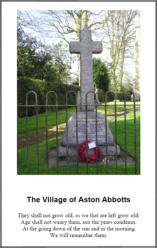




Few places in England could avoid being affected by the two great
global conflicts of the twentieth century and Aston Abbotts was no
exception.
In the Great War of 1914 to 1918 men from all over England signed
up to go and fight in the trenches of France and the men of Aston
Abbotts responded with patriotic enthusiasm. But the protracted
trench warfare was to see waste of human life on a hitherto
unimaginable scale. Hundreds of thousands perished as the battle
lines moved backwards and
forwards by tiny amounts.
When the conflict was over many
villages in England wished to
honour their men folk who had laid
down their lives for their country
and Aston Abbotts, in common with
so many other villages, erected a
memorial to its war dead.
The Aston Abbotts war memorial
was erected in 1919 and is on the
right at the entrance to the
churchyard. It is inscribed with
twelve names.
The sheer horror of this sacrifice
comes home when you consider
that the male population of the
village was around 125 at that time
and that perhaps a half of those
were of fighting age. Then you
realise that Aston Abbotts lost
about 20% of those eligible to fight
- nearly 10% of its male population
- in the Great War.
Unlike the First World War, when
the carnage and horror was distant
and for those at home realised only through newspaper reports, the
Second World War saw all people in England being touched more
directly.
Older residents joined the Home Guard and prepared to ward off an
expected invasion from Hitler's forces, whilst the younger men went
off to fight. Farming became a reserved occupation as food stocks
dwindled and rationing was introduced. A bomber crashed in a field
below Norduck Farm (this was later revealed to be a British bomber
shot down in error by a British Fighter). The airfield at the nearby
village of Wing brought a lot of military activity to the area. Evacuees
(children fleeing the bombing of London) arrived in Aston Abbotts.
The Abbey, the largest house in
Aston Abbotts, became the
wartime home of President Benes,
the exiled president of
Czechoslovakia. His government
occupied Wingrave Manor in the
neighbouring village a mile to the
South. Czech solders were billeted
in Nissen huts in the Abbey
grounds and on Norduck drive. One
of these huts is still there today.
When Benes returned to
Czechoslovakia in 1945 he made
several gifts to Aston Abbotts,
including a bus shelter which still
stands today at the Wingrave
crossroads, a road junction on the
A418 just south of the village.
As the fighting finished in 1945
German prisoners of war were
moved into the Nissen huts
formerly occupied by the Czech
soldiers and a tented prisoner of
war camp was created along the
drive to Norduck Farm. This was
known as POW Camp 268. Over
250 prisoners were kept there.
They were required to work and
some worked on the local farms
until they had been gradually repatriated over a two-year period.
In 2014 - the centenary of the outbreak of World
War 1 - a commemorative booklet was delivered to
each house in the village. The booklet - The Soldier
Lads of Aston Abbotts - was the culmination of
several years research by Simon Guy.
In the booklet Simon presented short biographies of
each of the soldiers named on the Aston Abbotts war
memorial.
You can now read the booklet on the Soldier Lads
page by clicking its picture on the right.
We are extremely grateful to Simon for making this
available and also grateful to Richard Clarke for
sponsoring the distribution of the original printed
booklet.

Click the picture to go to
the booklet




- Photos
- Aston Abbotts - Winter Pictures
- Aston Abbotts How It Was
- Villagers Pictures - General
- Villagers Pictures - Ken Rhodie
- 630 Club Bean Competition 2011
- Astonbury X 2011 - Page 1
- Astonbury X 2011 - Page 2
- Astonbury X 2011 - Page 3
- Vic Scott Memorial Orchard
- Christmas Lunch 2011
- Peter Kent's Photographs
- Jubilee Picnic 2012
- Village Orchard - One Year On
- Village Orchard - Autum 2012 Planting
- Astonbury 2012
- Videos
- Interviews















